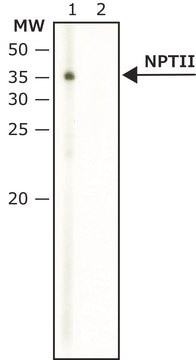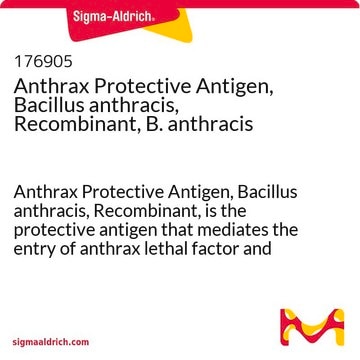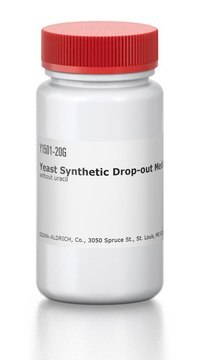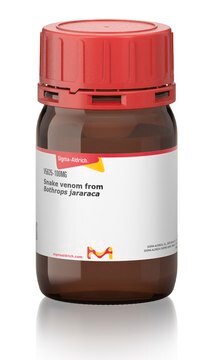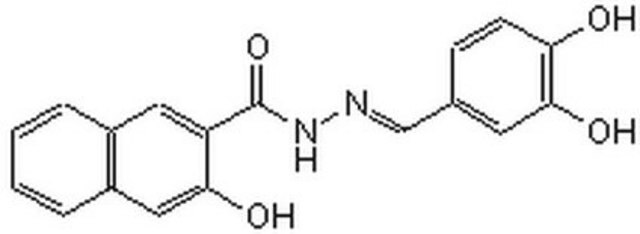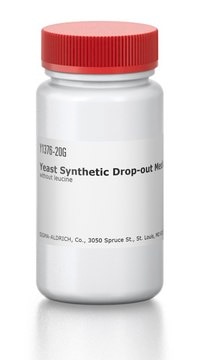176908
Anthrax Protective Antigen, Bacillus anthracis, Nicked, Recombinant, B. anthracis
Synonym(s):
PA 63, PA 63
Sign Into View Organizational & Contract Pricing
All Photos(1)
About This Item
UNSPSC Code:
12352202
Recommended Products
form
lyophilized
Quality Level
manufacturer/tradename
Calbiochem®
storage condition
OK to freeze
shipped in
ambient
storage temp.
2-8°C
General description
Recombinant, Bacillus anthracis anthrax protective antigen (nicked) expressed in a specialized strain of B. anthracis. PA63 is the carboxyl-terminal 63-kDa fragment obtained by the proteolytic cleavage of the receptor-bound protective antigen (PA), one of the three proteins that comprise anthrax toxin. Unlike native PA, PA63 oligomerizes to form a ring-shaped heptamer that binds up to three copies of EF and/or LF competitively and with high affinity (Kd ~1 nM). Whereas native PA persists on the cell surface, the heptamer is endocytosed, presumably because oligomerization aggregates anthrax toxin receptor. The endocytosed toxic complexes are trafficked to endosomal compartments where the low pH causes the PA63 heptamer to insert into the membrane and form a water-filled channel.
Recombinant, Bacillus anthracis anthrax protective antigen(nicked) expressed in a special strain of B. anthracis. PA63 is the carboxyl-terminal 63-kDa fragment obtained by the proteolytic cleavage of the receptor-bound protective antigen (PA), one of the three proteins that comprise anthrax toxin. Unlike native PA, PA63 oligomerizes to form a ring-shaped heptamer that binds up to three copies of EF and/or LF competitively and with high affinity (Kd ~1 nM). Whereas native PA persists on the cell surface, the heptamer is endocytosed, presumably because oligomerization aggregates anthrax toxin receptor. The endocytosed toxic complexes are trafficked to endosomal compartments where the low pH causes the PA63 heptamer to insert into the membrane and form a water-filled channel.
Biochem/physiol Actions
Cell permeable: no
Primary Target
EF and/or LF
EF and/or LF
Product does not compete with ATP.
Reversible: no
Warning
Toxicity: Standard Handling (A)
Physical form
Lyophilized from 100 mM NaCL, 10 mM BIS-Tris propane, 1.25% trehalose, pH 8.5.
Reconstitution
Following reconstitution aliquot and freeze (-20°C or- 70°C) for long term storage or refrigerate (4°C) for short-term (few hours) storage. Avoid rapid freeze-thaw cycles of solutions. Stock solutions are stable for up to 3 months at -20°C or -70°C.
Reconstitute in sterile 50% glycerol or sterile, distilled H₂O to a final concentration of 1 mg/ml. Addition of BSA to a concentration of 1 mg/ml may enhance stability.
Analysis Note
Single major band at 63 kD by SDS-PAGE
Other Notes
Mogridge, J., et al. 2002. Proc. Natl. Acad. Sci. USA99, 7045.
Nassi, S., et al. 2002. Biochemistry41, 1445.
Singh, Y., et al. 1999. Infect. Immun.67, 1853.
Leppla, S.H. 1988. Methods Enzymol.165, 103.
Nassi, S., et al. 2002. Biochemistry41, 1445.
Singh, Y., et al. 1999. Infect. Immun.67, 1853.
Leppla, S.H. 1988. Methods Enzymol.165, 103.
Legal Information
CALBIOCHEM is a registered trademark of Merck KGaA, Darmstadt, Germany
Storage Class
11 - Combustible Solids
wgk_germany
WGK 1
flash_point_f
Not applicable
flash_point_c
Not applicable
Certificates of Analysis (COA)
Search for Certificates of Analysis (COA) by entering the products Lot/Batch Number. Lot and Batch Numbers can be found on a product’s label following the words ‘Lot’ or ‘Batch’.
Already Own This Product?
Find documentation for the products that you have recently purchased in the Document Library.
Our team of scientists has experience in all areas of research including Life Science, Material Science, Chemical Synthesis, Chromatography, Analytical and many others.
Contact Technical Service